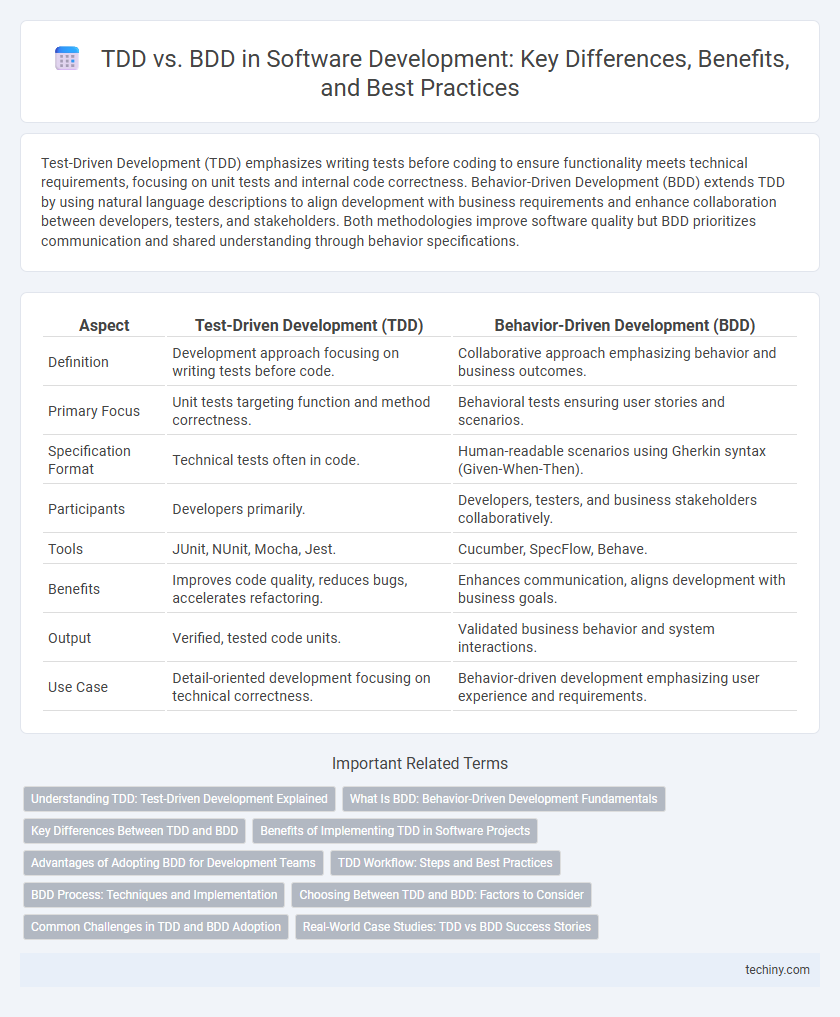Test-Driven Development (TDD) emphasizes writing tests before coding to ensure functionality meets technical requirements, focusing on unit tests and internal code correctness. Behavior-Driven Development (BDD) extends TDD by using natural language descriptions to align development with business requirements and enhance collaboration between developers, testers, and stakeholders. Both methodologies improve software quality but BDD prioritizes communication and shared understanding through behavior specifications.
Table of Comparison
| Aspect | Test-Driven Development (TDD) | Behavior-Driven Development (BDD) |
|---|---|---|
| Definition | Development approach focusing on writing tests before code. | Collaborative approach emphasizing behavior and business outcomes. |
| Primary Focus | Unit tests targeting function and method correctness. | Behavioral tests ensuring user stories and scenarios. |
| Specification Format | Technical tests often in code. | Human-readable scenarios using Gherkin syntax (Given-When-Then). |
| Participants | Developers primarily. | Developers, testers, and business stakeholders collaboratively. |
| Tools | JUnit, NUnit, Mocha, Jest. | Cucumber, SpecFlow, Behave. |
| Benefits | Improves code quality, reduces bugs, accelerates refactoring. | Enhances communication, aligns development with business goals. |
| Output | Verified, tested code units. | Validated business behavior and system interactions. |
| Use Case | Detail-oriented development focusing on technical correctness. | Behavior-driven development emphasizing user experience and requirements. |
Understanding TDD: Test-Driven Development Explained
Test-Driven Development (TDD) is a software development approach where developers write automated test cases before writing the functional code, ensuring each feature meets predefined requirements. This methodology emphasizes creating small, incremental tests that define desired behavior, enabling rapid identification and correction of defects during development. TDD fosters higher code quality, improved design, and maintainable software by aligning implementation with test specifications from the outset.
What Is BDD: Behavior-Driven Development Fundamentals
Behavior-Driven Development (BDD) emphasizes collaboration between developers, testers, and non-technical stakeholders to create clear, executable specifications based on user behaviors. It uses natural language constructs to define test scenarios, bridging the gap between technical implementation and business requirements. BDD frameworks like Cucumber support this approach by enabling automated tests that directly reflect desired behaviors, improving communication and reducing misunderstandings.
Key Differences Between TDD and BDD
Test-Driven Development (TDD) emphasizes writing tests based on functional requirements before coding, focusing on the implementation details and ensuring code correctness. Behavior-Driven Development (BDD) extends TDD by encouraging collaboration between developers, testers, and non-technical stakeholders through natural language scenarios, targeting system behavior and user experience. Key differences include TDD's code-centric approach versus BDD's emphasis on business outcomes and shared understanding using user stories and acceptance criteria.
Benefits of Implementing TDD in Software Projects
Implementing Test-Driven Development (TDD) in software projects significantly improves code quality by ensuring that testing drives design decisions and reduces bugs early in the development cycle. TDD promotes simpler, more modular code, which enhances maintainability and accelerates refactoring efforts. Teams adopting TDD report faster feedback loops and increased confidence in software reliability, leading to more predictable project outcomes.
Advantages of Adopting BDD for Development Teams
Behavior-Driven Development (BDD) enhances collaboration between developers, testers, and non-technical stakeholders by using natural language to define test scenarios, improving communication and requirement clarity. BDD promotes early detection of defects through shared understanding and precise acceptance criteria, resulting in higher-quality software and reduced rework. This approach fosters a user-centric mindset, ensuring that development aligns closely with business goals and end-user expectations.
TDD Workflow: Steps and Best Practices
Test-Driven Development (TDD) workflow involves writing a failing test case first, followed by writing minimal code to pass the test, and then refactoring the code for optimization. Best practices include maintaining small, incremental test iterations, ensuring tests are atomic and isolated, and keeping the feedback loop short to quickly identify and fix defects. Incorporating continuous integration tools enhances the workflow by automatically running tests, which supports code quality and reliable software development.
BDD Process: Techniques and Implementation
Behavior-Driven Development (BDD) enhances collaboration between developers, testers, and business stakeholders by using natural language to define test scenarios, improving clarity and alignment with business requirements. Core BDD techniques include writing user stories, defining scenarios with Given-When-Then syntax, and automating these scenarios with tools like Cucumber or SpecFlow to ensure continuous validation of features. Implementing BDD fosters early detection of defects, facilitates communication, and drives software development through executable specifications aligned with user behavior.
Choosing Between TDD and BDD: Factors to Consider
Choosing between Test-Driven Development (TDD) and Behavior-Driven Development (BDD) depends on project goals, team collaboration, and clarity of requirements. TDD emphasizes writing tests before code to ensure functionality, suitable for developers prioritizing technical correctness and unit-level precision. BDD focuses on stakeholder communication and shared understanding through natural language scenarios, ideal for projects requiring clear behavior definitions and cross-team alignment.
Common Challenges in TDD and BDD Adoption
TDD and BDD adoption often faces challenges such as unclear requirements, which lead to ineffective test cases and hinder development progress. Teams may struggle with the initial learning curve, causing slower test writing and integration into existing workflows. Maintaining test suites also poses difficulties, as frequent code changes require constant updates to keep tests relevant and reliable.
Real-World Case Studies: TDD vs BDD Success Stories
Real-world case studies reveal that Test-Driven Development (TDD) excels in improving code quality and reducing bugs in complex software projects, as demonstrated by companies like Microsoft and Uber. Behavior-Driven Development (BDD) enhances collaboration between developers and stakeholders by defining clear user scenarios, with successful implementations at organizations such as Cucumber and ThoughtWorks emphasizing user-centric features. Both methodologies contribute to agile development by fostering continuous feedback and iterative improvements, but project context and team dynamics often determine the ideal choice.
TDD vs BDD Infographic

 techiny.com
techiny.com